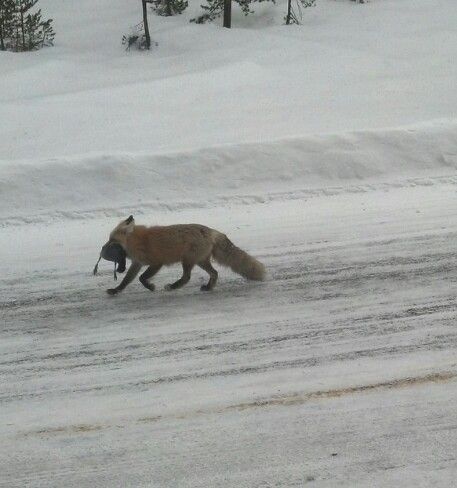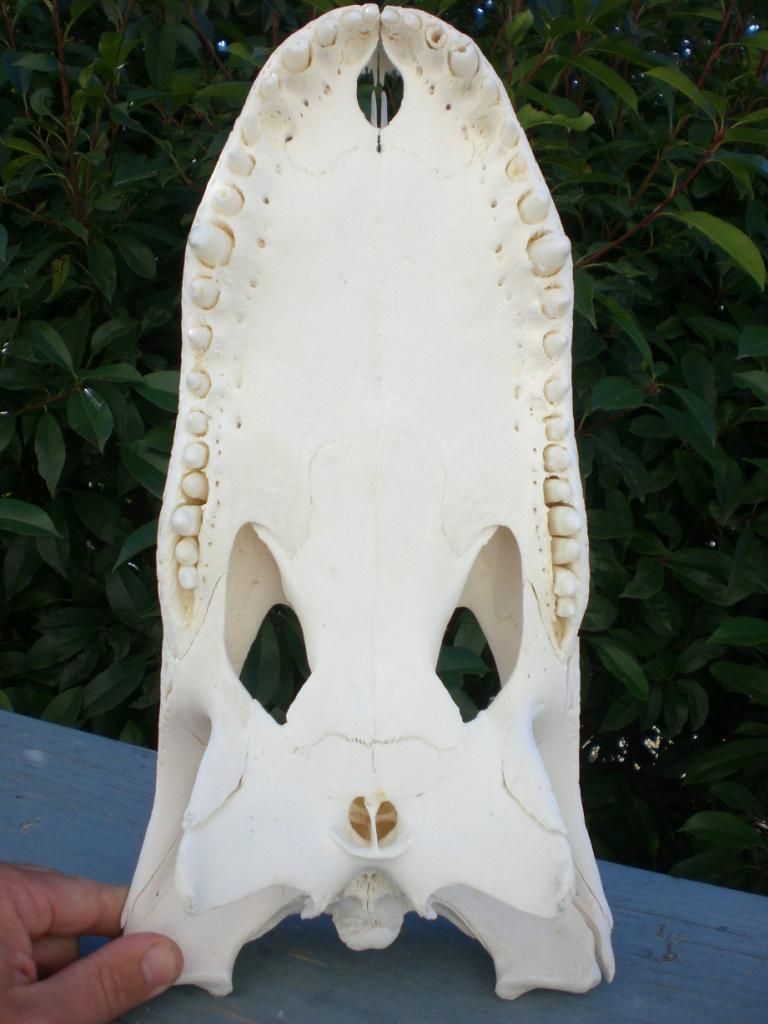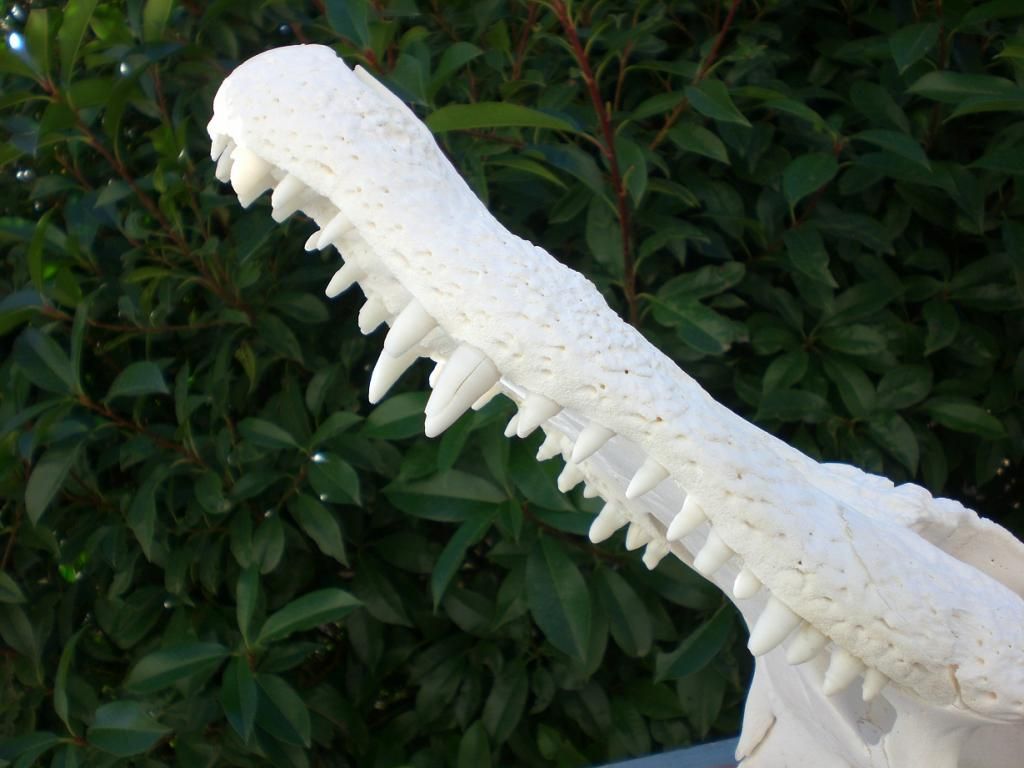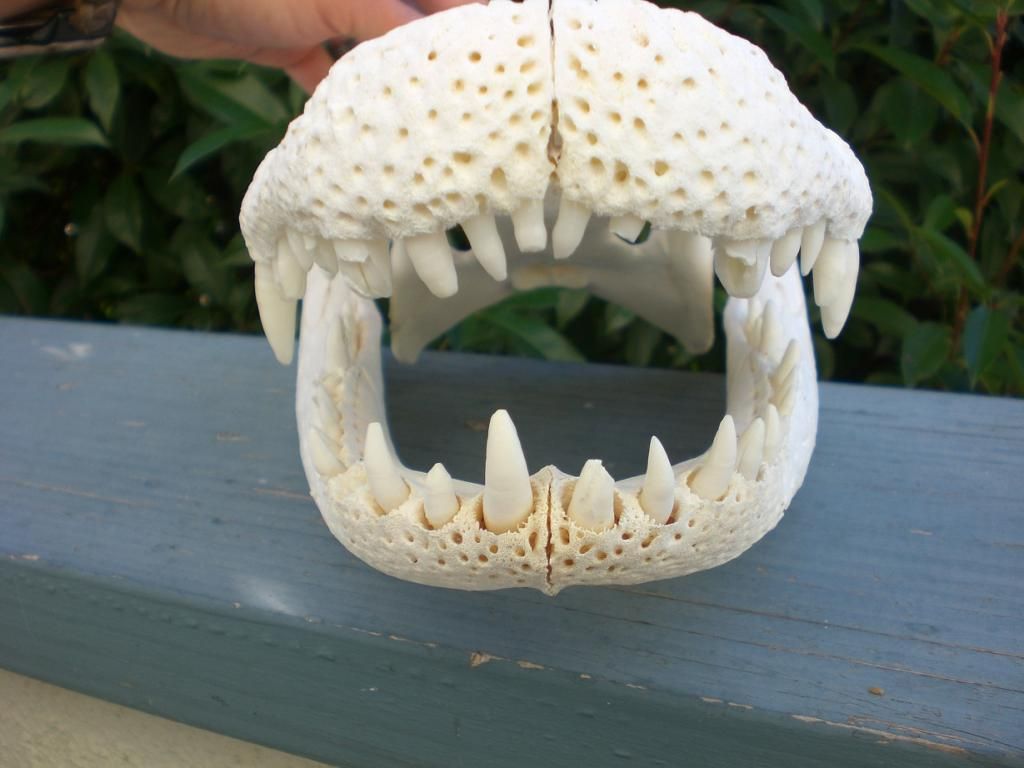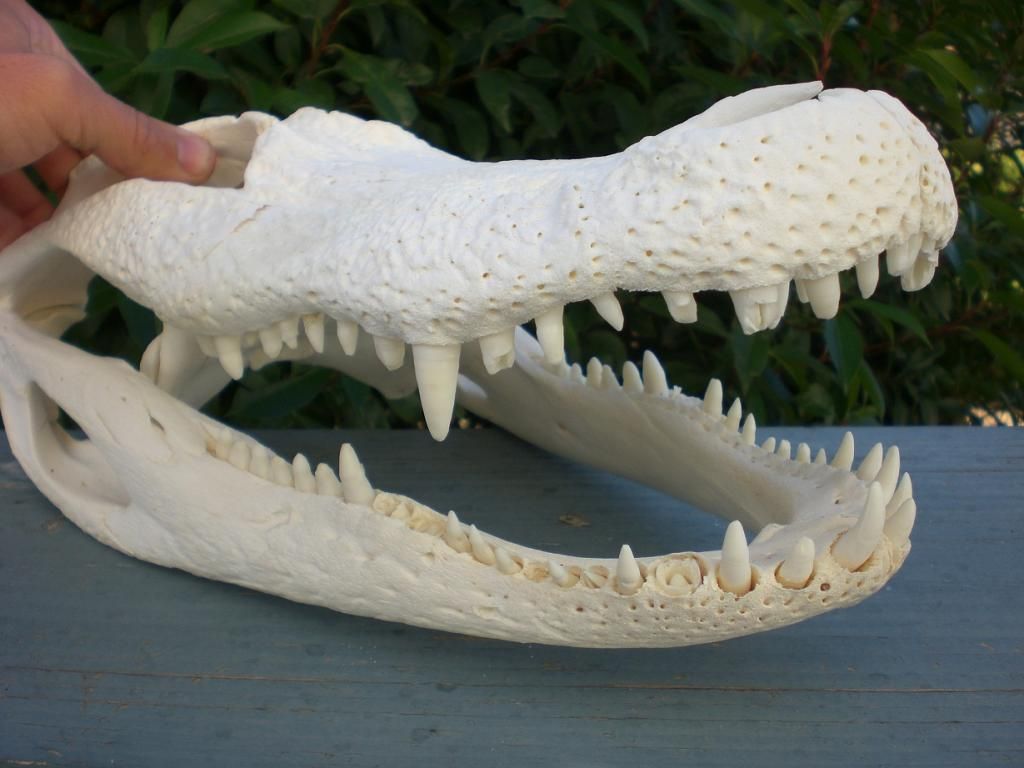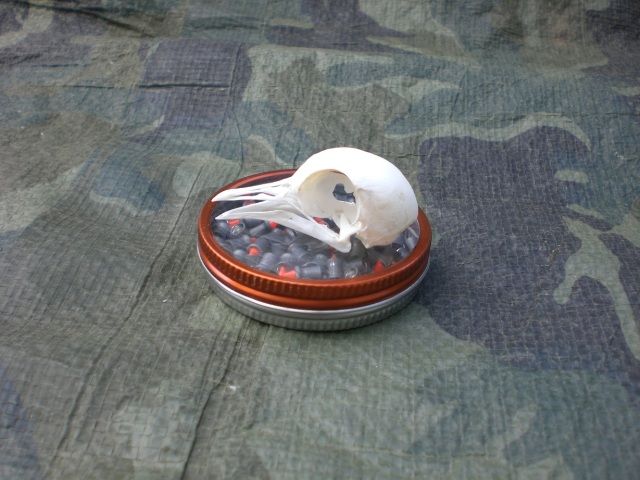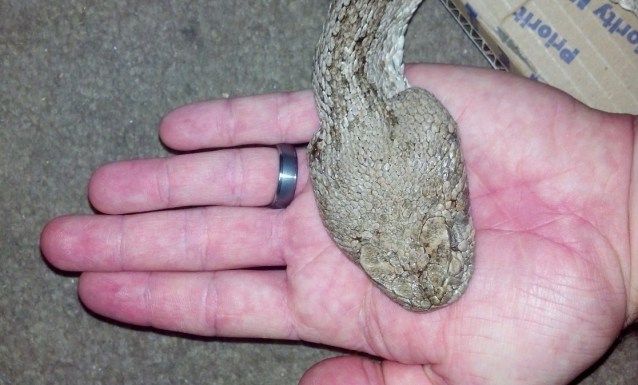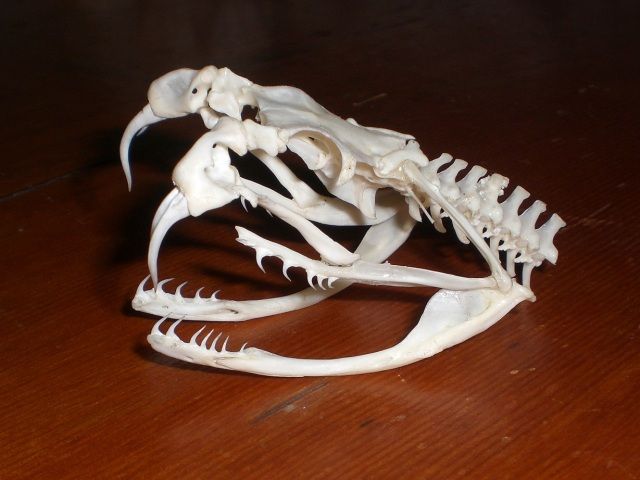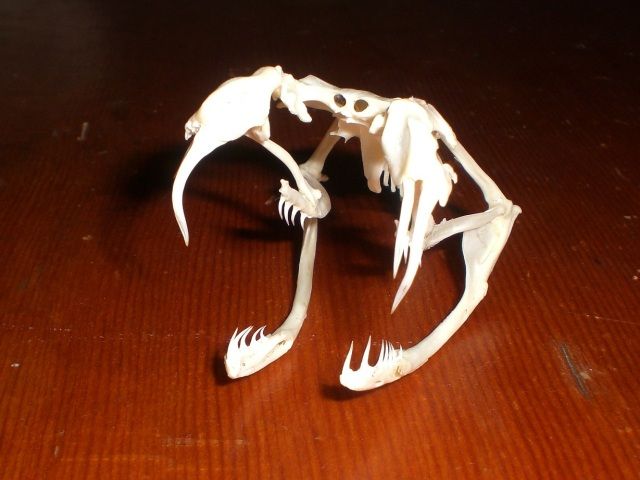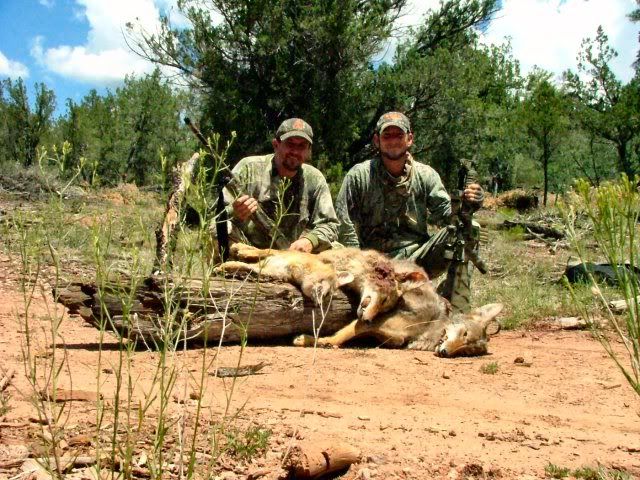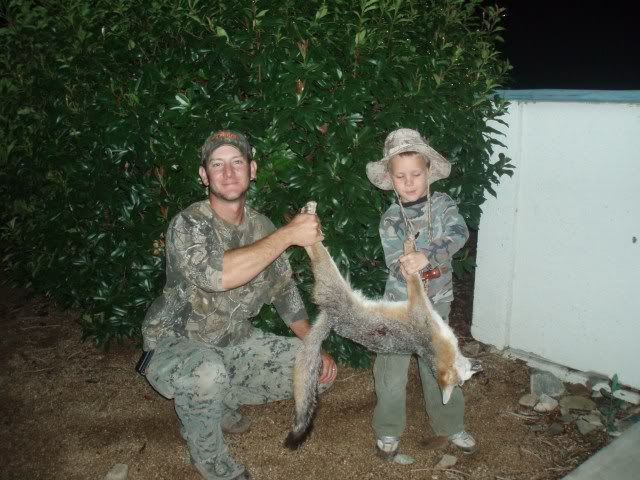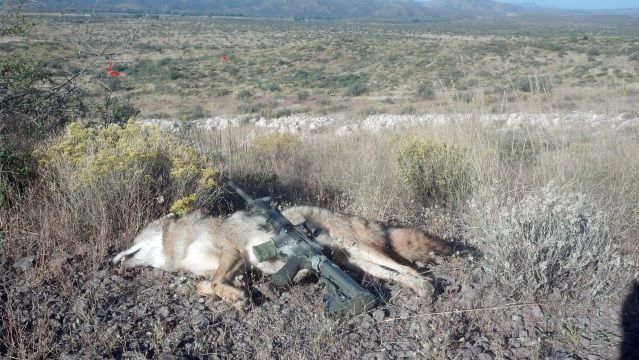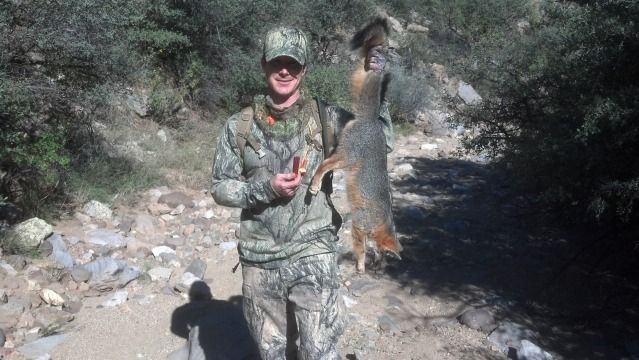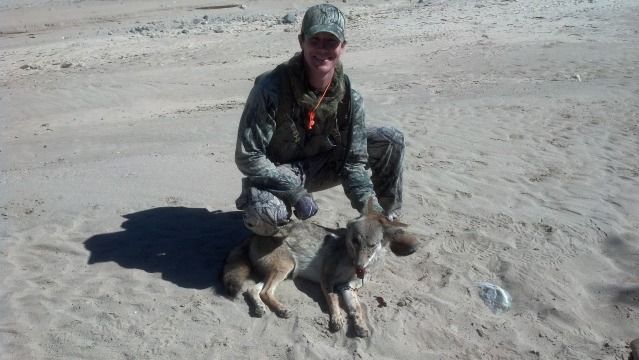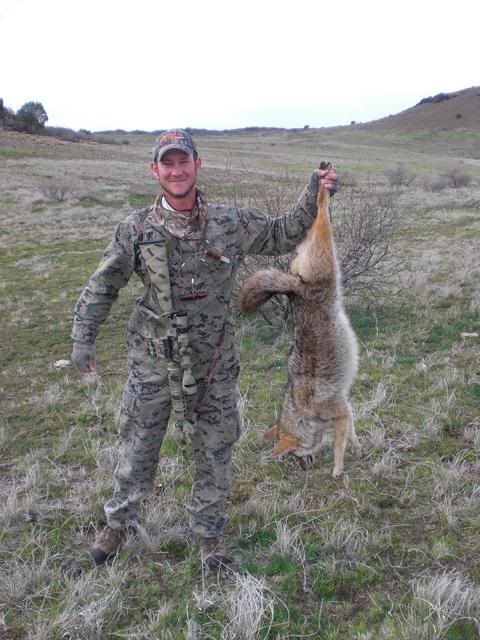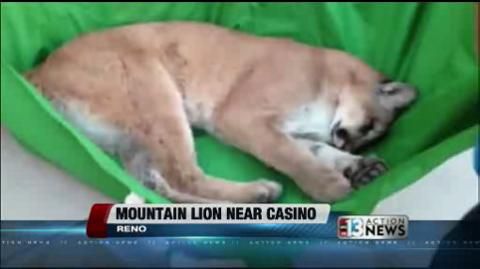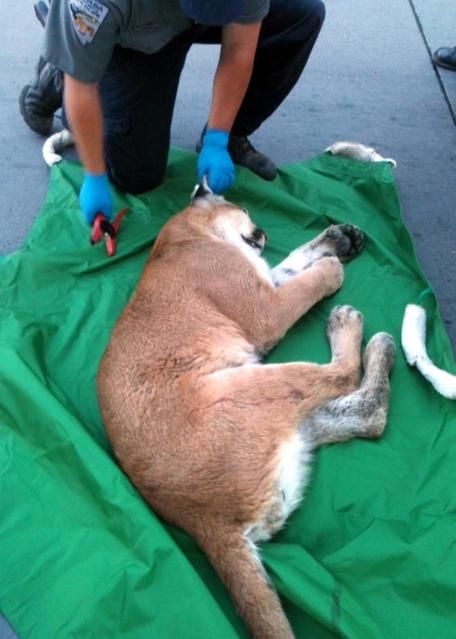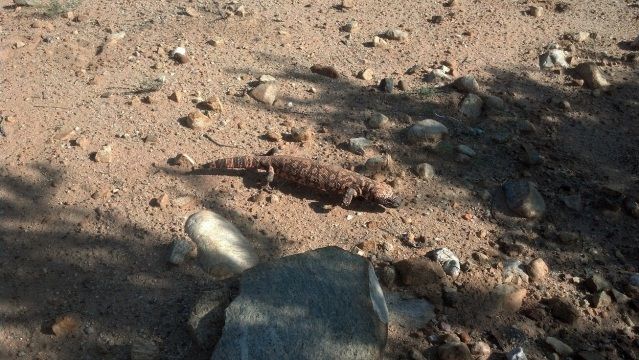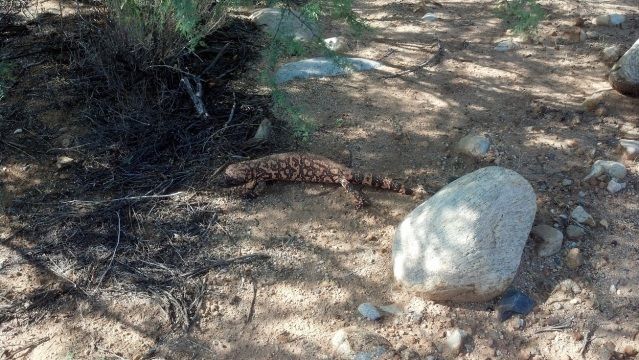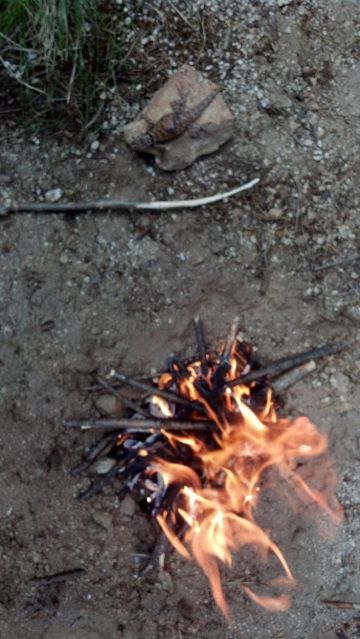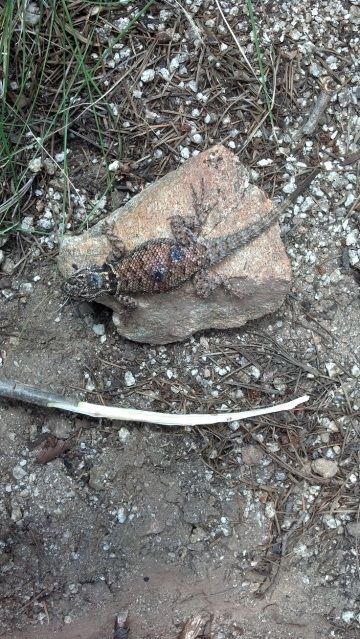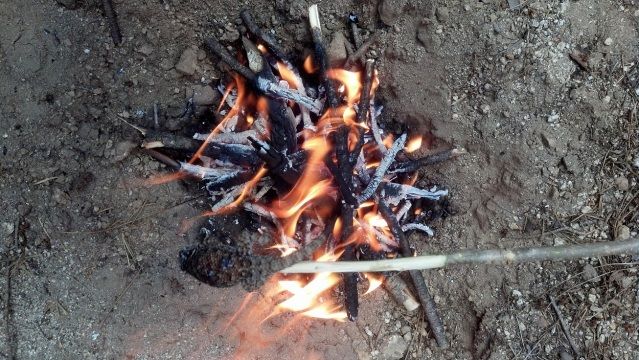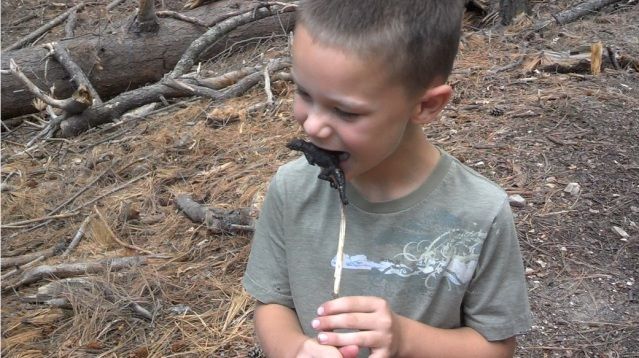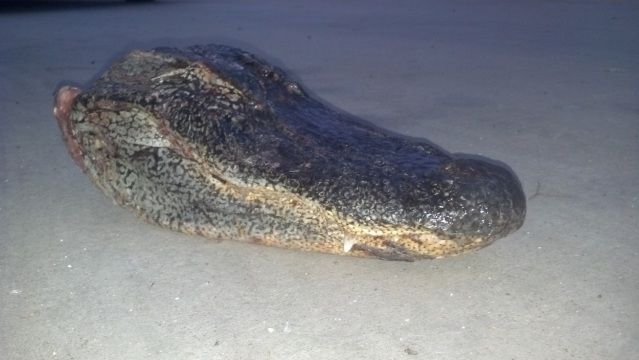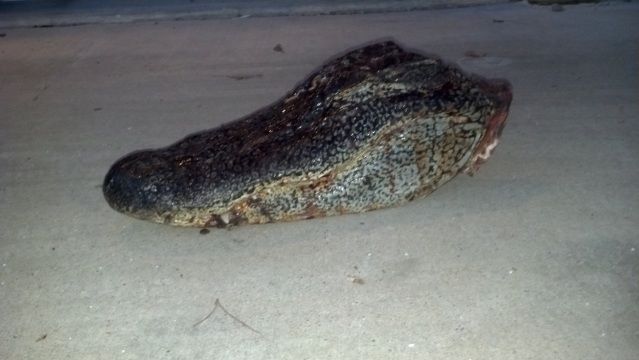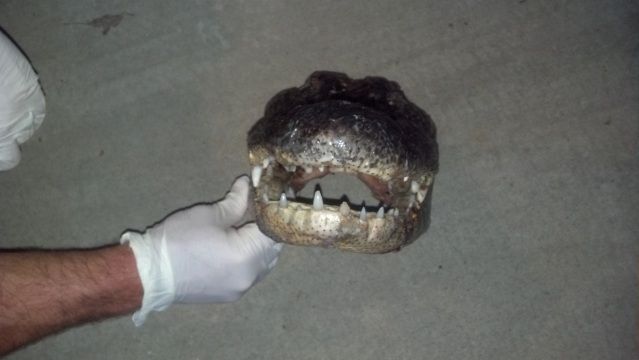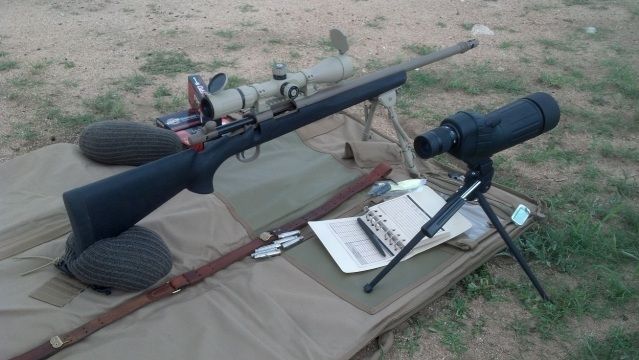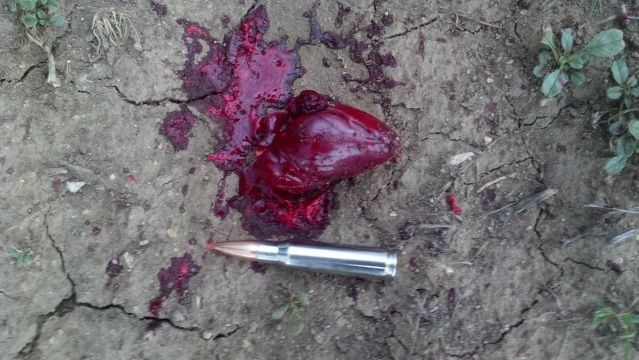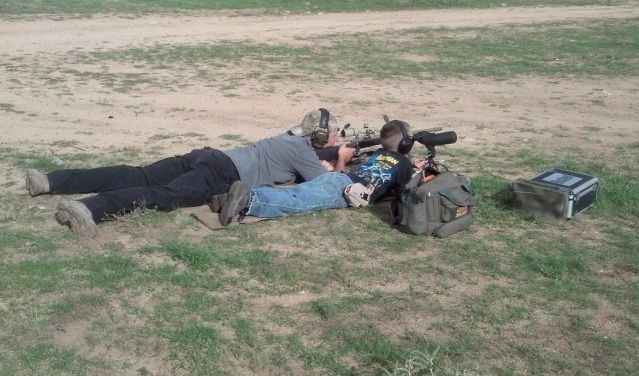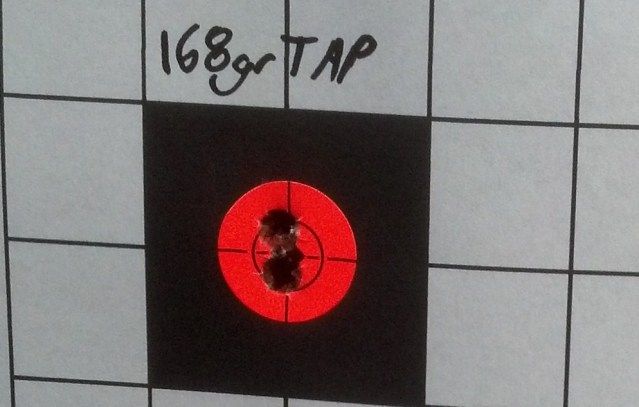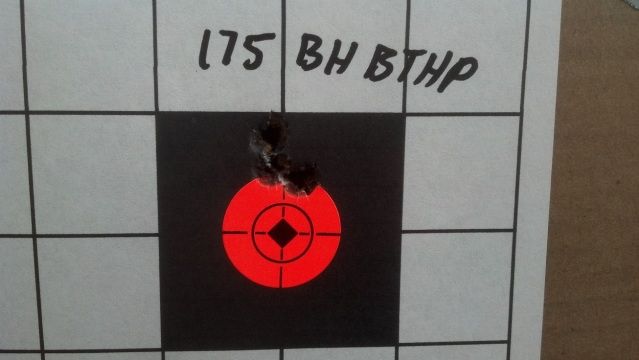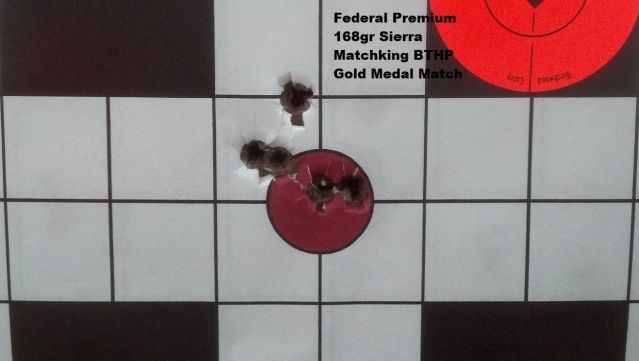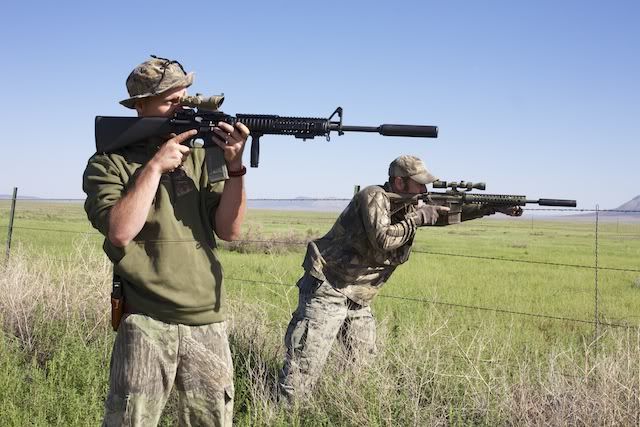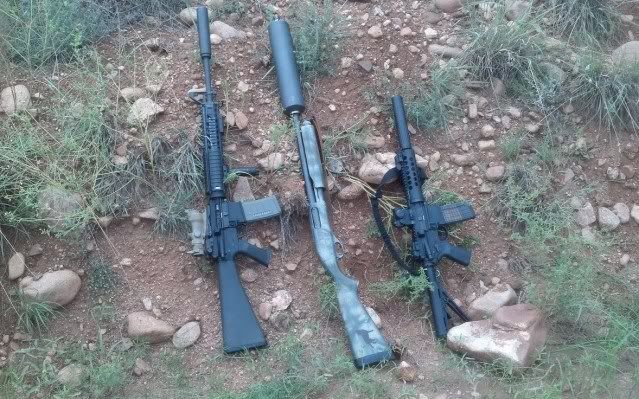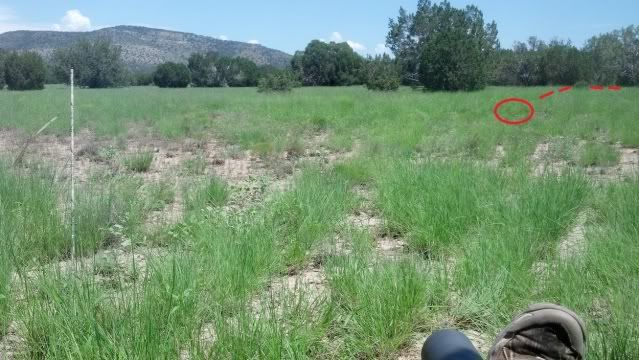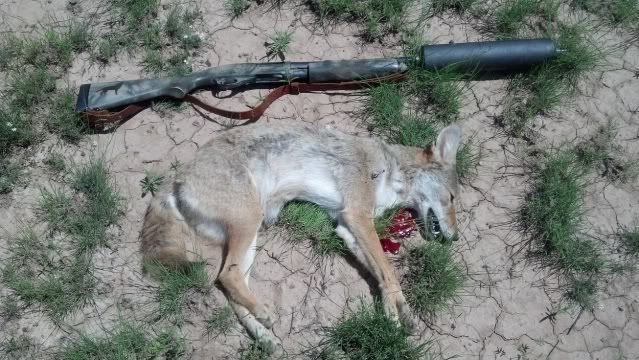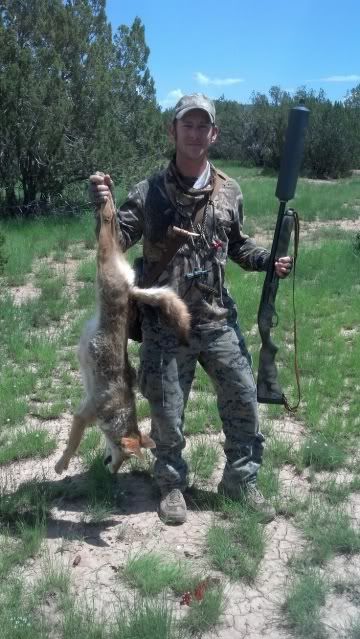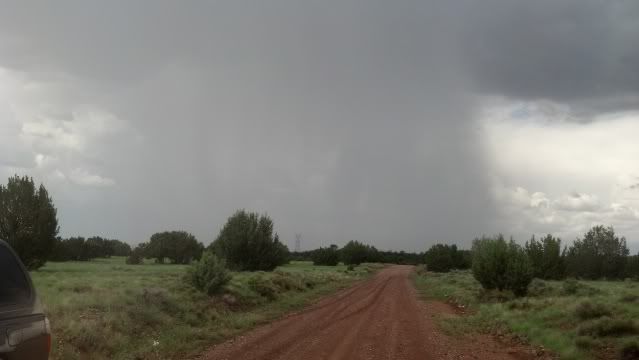I have an uncle in Wyoming who sent this picture out to the family yesterday, and I wanted to share it. My uncle was plowing the snow on a road near Jackson Lake when he spotted this red fox with an American coot in its mouth trotting down the plowed area. He seemed to pay no attention to my uncle until he tried to get more pictures, and then the fox jumped into the snow.
Once my uncle passed by where the fox had left the road, he looked in his rearview mirror and the fox popped back onto the nicely paved asphalt and continued on his way. Guess after chasing down and nabbing a coot, this ol' fox wanted to take the easy road!
Thanks for the picture Charlie!
Tuesday, December 18, 2012
Monday, November 26, 2012
Alligator skull is finally complete!
It's been a long time coming (here's the original gator post back in August), but the gator skull is finally complete! I've been really busy lately with training and such, but I had some time today to get the gator skull all wrapped up.
This has been a fun project, even if it seemed to take forever, but I really learned a lot since this was my first gator. There were several differences between this skull and the mammal skulls that I am so used to cleaning, such as the type of meat, the smell (stinky!), the way that the bone reacts to the whitening peroxide, and the way that the bone dries. I have two more gators to clean, and this one was the smallest of the three, so I'm looking forward to seeing how the others go.
Happy Hunting!
This has been a fun project, even if it seemed to take forever, but I really learned a lot since this was my first gator. There were several differences between this skull and the mammal skulls that I am so used to cleaning, such as the type of meat, the smell (stinky!), the way that the bone reacts to the whitening peroxide, and the way that the bone dries. I have two more gators to clean, and this one was the smallest of the three, so I'm looking forward to seeing how the others go.
Happy Hunting!
Thursday, November 8, 2012
Bird, Dog, Cat
Several weeks ago, a pigeon was messing around in my wife's garden, and then mysteriously dropped dead. ;-) Not one to let an opportunity go to waste, I realized that I had not cleaned a pigeon skull in the past - in fact, this is the smallest skull I have ever cleaned. It turned out really well!
Back in May at the Coyote Clinic, we skinned a coyote during the skinning demonstration that was provided by a former Coyote Clinic graduate. I was finally able to get around to cleaning the skull this last month, and thought it fitting that it should be displayed on the tire of my fur gettin' truck.
And I'm slowly working my way through a box of bobcat heads in my freezer, all of which were trapped last season. Here's a few of them that I finished over the last couple of weeks, with one particularly large skull on the right. I really like the way that the skulls reflect in the bumper of the fur gettin' truck.
More skulls are coming soon - the alligator is just about wrapped up (had a bit of a peroxide issue), and several nice mule deer bucks are being cleaned as of right now.
If anyone needs bobcat skulls, by the way, they are for sale. I'll also donate them to educational institutions, especially any that teach kids about responsible hunting or outdoor skills.
Happy Hunting!
Back in May at the Coyote Clinic, we skinned a coyote during the skinning demonstration that was provided by a former Coyote Clinic graduate. I was finally able to get around to cleaning the skull this last month, and thought it fitting that it should be displayed on the tire of my fur gettin' truck.
And I'm slowly working my way through a box of bobcat heads in my freezer, all of which were trapped last season. Here's a few of them that I finished over the last couple of weeks, with one particularly large skull on the right. I really like the way that the skulls reflect in the bumper of the fur gettin' truck.
More skulls are coming soon - the alligator is just about wrapped up (had a bit of a peroxide issue), and several nice mule deer bucks are being cleaned as of right now.
If anyone needs bobcat skulls, by the way, they are for sale. I'll also donate them to educational institutions, especially any that teach kids about responsible hunting or outdoor skills.
Happy Hunting!
Tuesday, October 30, 2012
BIG Diamondback Rattlesnake Skull!
A hunter that I know named Roger contacted me several weeks ago after killing a massive diamondback rattlesnake while out coyote hunting. He wanted to get the skull cleaned up, and would be in my neck of the woods, so I had him stop by and drop the head off.
When it came time to put the head in the beetles, I placed it in the palm of my hand to see just how big it was - and I have to say that this was a very creepy thing to do! I'm not scared of snakes or anything like that, but this snake's eyes were still open, and after seeing how long snakes can move around after they are dead, it just made me squirm a little. This is one big rattlesnake head!
After the beetles were done with the head, the real work began. The tough part about rattlesnakes is that their bones aren't really connected - they are mostly held together with muscles and such. So when the skull is cleaned, it completely falls apart! It's a pretty painstaking process to hold it all together just right and apply the appropriate amount of super glue where needed, especially when youa re trying to go for a certain position with the skull. Most of the time, this process can take over an hour. Here's the skull once it was completed:
Keep an eye out for those rattlesnakes when you are out hunting and hiking! Sneaky devils, I tell ya.
Happy Hunting!
Wednesday, October 17, 2012
Choose Your Hunting Partners Carefully!
Every year, I read dozens of stories about hunters accidentally shooting other hunters, outdoor enthusiasts, and even game wardens. Most of these incidents occur because people aren't following the basic firearm safety rules, specifically knowing your target and what's beyond it. Sometimes it's a hunter who gets shot because he "looked like a deer", sometimes it's a game warden who gets shot because he "just popped out of the bushes and startled me", and sometimes it's a casual hiker or camper who gets hurt because they were in the wrong place where an errant bullet landed. Needless to say, most of these situations could have easily been avoided, but what's even worse about getting shot by a stranger is when you get shot by your own hunting partner.
Those types of shootings can also be avoided, again primarily by following the firearm safety rules, and also by keeping a sharp situational awareness. Camouflage is sometimes blamed for this, as was the case in the story that I read this morning from Michigan, which involved four duck hunters. Three of the duck hunters had decided to head back for the day, and the remaining hunter was not 100% sure of the route they took on their return. Due to his poor eyesight, he claims that he did not see his hunting partners, dressed in camouflage, when a duck flew between himself and his partners. He fired at the duck, and instead peppered his own hunting partners, who were treated for birdshot wounds to the neck but later released from the hospital. The condition of the duck is unknown, but I'll guess that he lived to fly another day. You can read the entire story here: http://www.mlive.com/news/flint/index.ssf/2012/10/three_people_injured_after_bei.html
My point is, be careful about the partners that you choose. Make sure that they understand the firearm safety rules - and this does not mean assume that they know them because they've been shooting for years / hunting a lot / in the military / etc. Discuss safety and safe lanes of fire - make sure they understand that no shot on an animal is worth putting a human life at risk. Also, make sure that your partner wants the same results from the hunt that you do. Whether you are laid back and hunting-for-fun, or a super competitive, gotta-kill-something hunter, you need a partner that shares your views and your desired results. Choosing the wrong partner can result in one or both of you not enjoying the time spent hunting, or even worse, can result in arguments. You also need to make sure that your partner(s) knows exactly where you are at all times! Whether you are in a bush, on a stand, or going to water a tree, anyone with you needs to know about that! Simple communication could have prevented several of the hunting accidents that I have read about already this year.
So be careful out there, and choose to hunt only with those who share your sporting passion and safe habits!
Happy Hunting!
Friday, October 5, 2012
Brand New Lessons and Old Lessons Re-Learned
I once heard someone that I respect say, "Anything you learn but can't share is wasted." To that end, I really enjoy taking new hunters out to get some predators in front of them, and this past Monday I had the opportunity to go hunting with a new predator hunter named Matt.
We got to the first stand at daylight, which in the past has been a stand that has really produced for me, as it is on private land. In the last year, however, one of the owners has moved onto the land, and that activity seems to have driven the predators along another path somewhere other than this small patch of land. As a consequence, neither the first nor second stand produced anything other than a few cows - cranky cows, I might add.
The third stand found me sitting on a hill overlooking the entire area while Matt hung close to my FoxPro with his shotgun, in hopes that anything we drew up the security routes close to the caller would fall to a load of #4 buckshot. After about 10 minutes of prey distress, I switched to pup distress, and when that failed to produce anything after a few minutes, I called the stand off. As I always do when I end a stand, I stood up slowly and surveyed the area, hoping to catch a sight of any approaching animals I hadn't already seen. As I scanned, I caught movement on a hill about 300 yards away - it was an animal in the shadows that appeared to be approaching the stand, but I couldn't make it out. I took a solid supported kneeling position, and rested my 2 MOA red dot on the general vicinity of the movement, waiting for an opportunity to identify the source. As the animal stepped into the sunlight, I made out the unmistakable outline of a coyote, and when it stopped to do its own survey of the area, I settled that red dot on the chest and compressed the trigger. BANG-FLOP - that coyote went down like a sack of wheat. As we made the long trek to recover the coyote, I realized that this was the longest shot I had ever made on a predator with my unmagnified red dot optic, which is the Primary Arms Micro Dot.
If you click on the picture below, you'll see a red arrow in the top left corner where Matt was sitting, a red circle nect to that where the FoxPro was, and on the hill to the right you will see a small red X - that's where I was when I shot the coyote.
Brand New Re-Learned Lesson #1: Always look around as you are standing up after a stand
Brand New Re-Learned Lesson #2: Shooting practice and training with your hunting firearms pays off
Brand New Re-Learned Lesson #3: Sit tight on stand, even after you shoot - predators aren't always scared away by a little gunfire
Brand New Re-Learned Lesson #4: Anyone can miss, even with a shotgun - practice with your firearms and be ready for fast action when hunting predators
We did a few more stands in that canyon, but to no avail, so we headed off to explore some new country. Hiking into another small canyon, we found ourselves in very tough terrain to hunt, so even though we gave it our best shot at another stand, we decided to continue on down the road after a really tasty lunch. For our first afternoon stand we setup in a big dry wash - it was perfect country to catch a coyote napping in the thick brush, trying to avoid the hot sun. As we settled into position, I decided to go back to using my FoxPro, but when I hit the buttons on the remote, nothing happened. Sometimes the line-of-sight issue can mess with the caller, so I stood up, but still nothing. I walked over to the caller, and discovered that while it was in my bag the speaker switch had gotten turned to off! Turning it back on, I headed back to my cozy little spot under a tree and the calling began. After several minutes of low-volume bird distress, I went to my favorite bird distress call, Lucky Bird, and in less than a minute there was a hard charging coyote headed right for the caller and decoy. The coyote's path would take him right in front of Matt, which was just as we'd planned. I lost sight of the coyote behind a small bush as he got within 2-3 feet of the caller, and then BOOM BOOM -Matt's shotgun roared twice, but before I could figure out what had happened, I saw the coyote headed right towards Matt! The coyote was literally charging straight towards him, but Matt still had 1 shotgun shell left and he dumped it right into the coyote's face - at around 15 feet! The dog went down hard, and since Matt was out of rounds, we ended the stand. Wow! What an event we had just witnessed, and Matt had just dumped his second predator! If you click on the top picture below, you'll be able to see all of the pellet holes in the coyote's face - it was quite a shot!
Brand New Re-Learned Lesson #5: Even if you have some issues getting everything setup just right, always play out a stand that looks too good to pass up
Brand New Re-Learned Lesson #6: With predator hunting, you have to be Ready for Anything!
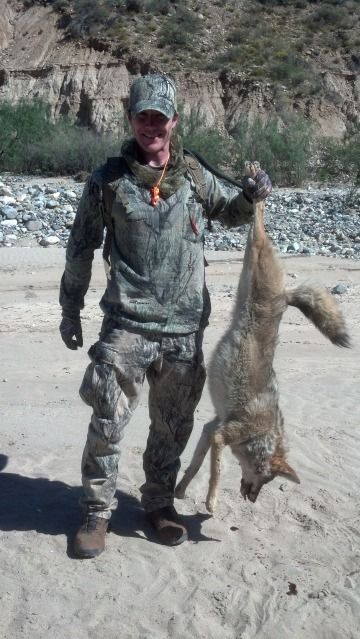
After we left the dry wash, we found some seriously attractive bobcat country, but a couple of stands yielded nothing other than a few hawks trying to scoop up the caller, so we decided to call it a day. And what a day it was! One of the things that I like to tell all of the hunters that I hunt with at the end of the hunt is that every time I go out, I either learn something new or re-learn old lessons - if you're not learning, then you're not trying hard enough! Matt went home very happy, and there were plenty of brand new lessons and old lessons that were re-learned for both of us.
Happy Hunting!
Wednesday, September 19, 2012
Coyote Contraceptives
The pronghorn population has been on a steady decline in Arizona for over 20 years now, and most of that is thanks to the coyote. Even with hunting, trapping, poisoning, and even aerial gunning, we humans can barely make a dent in the overall population. In fact, the coyote population is growing in some areas! This is happening all over the western United States, and is now spreading into the midwest and eastern areas as the coyote populations grows there, too - even in places where historically there were no coyotes. So how do we stop this spread?
It seems that my home town of Jackson Hole, Wyoming has an interesting idea: coyote contraceptives. Based on research done in Utah and Colorado, Wyoming is looking to make coyotes sterile through the use of a drug, though the delivery system is still just theory based at this point. It's an interesting story, so read more about it HERE.
With that being said, I still find this to be the most enjoyable way to do what I can to control the coyote population, even if it is barely making a dent:
It seems that my home town of Jackson Hole, Wyoming has an interesting idea: coyote contraceptives. Based on research done in Utah and Colorado, Wyoming is looking to make coyotes sterile through the use of a drug, though the delivery system is still just theory based at this point. It's an interesting story, so read more about it HERE.
With that being said, I still find this to be the most enjoyable way to do what I can to control the coyote population, even if it is barely making a dent:
Happy Hunting!
Friday, September 14, 2012
Revolving doors prevent gambling addictions for NV Mountain Lions
I've heard of cougars in casinos, but not like this! Apparently, mountain lions can't quite figure out how revolving doors work, which is a good thing, since the last problem we need in the woods is a mountain lion gambling addiction or underground wildlife gambling rings!
RENO - A mountain lion that was caught after trying to enter a Reno casino is back in the wild.
The 2-year-old male cougar was released into the Carson Range above Lake Tahoe's east shore on Saturday morning, said Chris Healy, spokesman for the Nevada Department of Wildlife.
"He was fully ready to go," Healy said. "He was feisty in the trap and snarled if you got too close. Once he decided to go, he quickly ran off into the underbrush and was gone."
Guests at Harrah's reported seeing the 100-pound cat trying to walk into the casino around dawn Friday. When the animal couldn't negotiate the revolving door, it hid under an outdoor stage where it was tranquilized and captured.
Wildlife officials speculate the cougar was chased out of the nearby Sierra Nevada foothills by the drought or by an adult cat that didn't want competition for a mate. They believe the cat followed the Truckee River into Reno.
Mountain lion sightings have been reported around Reno in the past, Healy said, but not in the downtown casino area.
Wildlife biologists say the Carson Range is good mountain lion habitat that features an abundance of mule deer and smaller prey in the summer.
"The mountain lion is unlikely to stay in any area until it finds an area of its own," Healy said.
The cougar was fitted with a collar that will track its movements, and officials hope it stays in the wild.
"The best-case scenario is we never see it or hear from it again," Healy said, adding the cat probably would be euthanized if it turns up in a city again.
The mountain lion was released a couple miles south of U.S. Highway 50 in the Spooner Summit area.
http://www.ktnv.com/news/local/167338135.html
http://www.lvrj.com/news/mountain-lion-that-tried-to-enter-reno-casino-set-free-near-lake-tahoe-167464775.html
RENO - A mountain lion that was caught after trying to enter a Reno casino is back in the wild.
The 2-year-old male cougar was released into the Carson Range above Lake Tahoe's east shore on Saturday morning, said Chris Healy, spokesman for the Nevada Department of Wildlife.
"He was fully ready to go," Healy said. "He was feisty in the trap and snarled if you got too close. Once he decided to go, he quickly ran off into the underbrush and was gone."
Guests at Harrah's reported seeing the 100-pound cat trying to walk into the casino around dawn Friday. When the animal couldn't negotiate the revolving door, it hid under an outdoor stage where it was tranquilized and captured.
Wildlife officials speculate the cougar was chased out of the nearby Sierra Nevada foothills by the drought or by an adult cat that didn't want competition for a mate. They believe the cat followed the Truckee River into Reno.
Mountain lion sightings have been reported around Reno in the past, Healy said, but not in the downtown casino area.
Wildlife biologists say the Carson Range is good mountain lion habitat that features an abundance of mule deer and smaller prey in the summer.
"The mountain lion is unlikely to stay in any area until it finds an area of its own," Healy said.
The cougar was fitted with a collar that will track its movements, and officials hope it stays in the wild.
"The best-case scenario is we never see it or hear from it again," Healy said, adding the cat probably would be euthanized if it turns up in a city again.
The mountain lion was released a couple miles south of U.S. Highway 50 in the Spooner Summit area.
http://www.ktnv.com/news/local/167338135.html
http://www.lvrj.com/news/mountain-lion-that-tried-to-enter-reno-casino-set-free-near-lake-tahoe-167464775.html
Tuesday, September 4, 2012
Labor Day Lizards
I have seen, touched, photographed, or hunted nearly every animal, reptile, insect, and critter that lives in Arizona. But there is one creature that I have never seen before in the wild and have always wanted to see, and that is a gila monster. When I was about 9 years old I saw a dead one by the highway near Roosevelt Lake, and other than seeing them in zoos and sanctuaries, I have never had the chance to see one alive in the wild.
This last weekend my wife and I were hiking just outside of Safford, AZ when I almost tripped over this guy chilling in the shade of a bush - he startled me so badly that I actually instinctively brought my rifle up to engage! Walking along and then nearly tripping over a desert dragon was not something I had experienced before.
He didn't care much about us, so I took several pictures of him, and got as close as I though prudent, given the gila monster's reputation for being cranky and that whole poisonous / locking jaw thing. Once we started moving around more, he decided to leave, but his attitude was like "I am moving because I want to, not because you are here, and if you come a little closer I will give you something to remember me by." He was the badass of the desert, that's for sure. It was a very cool experience, made even more so because my wife was there to see it with me.
Once we got back to the cabin where our kids were hanging out with some other family, we had another lizard experience for this year's Labor Day. My son was hunting with his trusty Red Ryder BB gun, and he decided that he wanted to hunt for lizards, so I told him he could hunt them only if he ate what he killed. A few minutes later he brings me a big ol' lizard, so we dig a fire pit, he starts a fire with his flint and steel, and we're ready for a mid-day snack.
Lizards are a great source of protein, and if you can catch them or kill them without totally destroying them, they make for a decent meal. Lizards are generally plentiful around Arizona, so it's a good thing to consider when you are thinking about 'survival' food sources. Here are my son's preps and a picture of him roasting the lizard over the flame:
We cooked the lizard for a good 10 minutes - a nice, slow roast - and then it's good to go. You want to cook lizards really well to avoid any parasites or other nasty things that may be living inside or on the skin. My son got a little excited and got him a bit close to the fire for a bit, so he charred him a little. The video of him eating it didn't really work out the way I wanted it to, but here's a picture of his first bite. I told him to get right in on the belly, and he went for it. Lizard on a stick, anyone?
In the end, I had to show him how it was done, and I ended up eating most of it (not a new thing for me) but he definitely got his share of lizard. What a tasty treat! I especially enjoyed the legs. If you've never tried it, I highly recommend it. A bit chewy, but tastes quite a bit like canned fish - think kippered snacks. You eat them bones and all, and while some people eat the whole thing, I toss the head and tail - those are mostly bone anyway.
Happy Hunting!
This last weekend my wife and I were hiking just outside of Safford, AZ when I almost tripped over this guy chilling in the shade of a bush - he startled me so badly that I actually instinctively brought my rifle up to engage! Walking along and then nearly tripping over a desert dragon was not something I had experienced before.
Once we got back to the cabin where our kids were hanging out with some other family, we had another lizard experience for this year's Labor Day. My son was hunting with his trusty Red Ryder BB gun, and he decided that he wanted to hunt for lizards, so I told him he could hunt them only if he ate what he killed. A few minutes later he brings me a big ol' lizard, so we dig a fire pit, he starts a fire with his flint and steel, and we're ready for a mid-day snack.
Lizards are a great source of protein, and if you can catch them or kill them without totally destroying them, they make for a decent meal. Lizards are generally plentiful around Arizona, so it's a good thing to consider when you are thinking about 'survival' food sources. Here are my son's preps and a picture of him roasting the lizard over the flame:
We cooked the lizard for a good 10 minutes - a nice, slow roast - and then it's good to go. You want to cook lizards really well to avoid any parasites or other nasty things that may be living inside or on the skin. My son got a little excited and got him a bit close to the fire for a bit, so he charred him a little. The video of him eating it didn't really work out the way I wanted it to, but here's a picture of his first bite. I told him to get right in on the belly, and he went for it. Lizard on a stick, anyone?
In the end, I had to show him how it was done, and I ended up eating most of it (not a new thing for me) but he definitely got his share of lizard. What a tasty treat! I especially enjoyed the legs. If you've never tried it, I highly recommend it. A bit chewy, but tastes quite a bit like canned fish - think kippered snacks. You eat them bones and all, and while some people eat the whole thing, I toss the head and tail - those are mostly bone anyway.
Happy Hunting!
Tuesday, August 28, 2012
Gator Heads
I have cleaned a lot of skulls over the years, including regular ol' coyotes, trophy bears, massive deer, and tiny little mice. But a gator? Well, that's a new one for me, so when a hunter from Texas contacted me about cleaning some gator skulls for him, I jumped at the opportunity. You may remember my post about how this hunter shipped the skulls to me back at the beginning of this month, which can be found here.
Now the time has come to start cleaning them up, so I pulled out the smallest of the three alligator heads, which is still quite large. I have to say that as I was carving off a few remaining large chunks of flesh, I was a little nervous - I kept looking at those closed eyes, expecting them to slide open any moment as the jaws starting snapping, like some horror movie! I know it sounds crazy, but it's my first time ever handling a gator, dead or alive.
Now the time has come to start cleaning them up, so I pulled out the smallest of the three alligator heads, which is still quite large. I have to say that as I was carving off a few remaining large chunks of flesh, I was a little nervous - I kept looking at those closed eyes, expecting them to slide open any moment as the jaws starting snapping, like some horror movie! I know it sounds crazy, but it's my first time ever handling a gator, dead or alive.
The lower jaw is just about done, and the upper section of the head will be getting cleaned next. I'll be posting up the pictures as soon as the first gator is completely done, so keep an eye on this blog for more info!
Oddly enough, as I was getting ready to write this post I got an email from Outdoor Life in which one of their main article was about a trapper in Florida who just caught a record 14ft, 900lb alligator - in a residential lake! Even more amazing was that in the process, he caught several other alligators, including two 11ft gators. Sheesh - remind me not to swim in Florida lakes. You can find the entire story here.
Happy Hunting!
Tuesday, August 21, 2012
Jackrabbit Heart Shot
I went out last night to sight in a new scope and rifle for Independence Training's new Precision Rifle course, and when I was done I was sitting on my shooting mat putting some info in my dope book when my son says "Hey, a jackrabbit!" I look up to see this big ol' jackrabbit about 50 yards away rolling around in the dirt, so I slowly open a box of ammo, load a round into the chamber of my rifle, and roll into the prone position. The rabbit never saw me until it was too late and a 168gr Hornady TAP round slammed into his boiler room - first blood for my new rifle. What you see in the picture below is the exit wound, but what else is in the picture is the weirdest thing I have ever had happen when shooting a jackrabbit - the TAP round blew the rabbit's heart out, whole and complete and without a scratch, and it landed right where you see it in the picture. Craziest thing I have ever seen.
Every good shooter needs a good spotter, and I have one of the best.
For those of you interested in my rifle setup, it is a Remington 700 SPS AAC-SD in .308 WIN with Nightforce 1-piece 20 MOA rail and medium Nightforce rings, all of which came from our friends over at STG Firearms. The scope is the Primary Arms 4-14x44mm FFP mil-dot, courtesy of Marshall at Primary Arms. This is a very excellent setup, and as you can see by the groups below, it gets the job done. I'll be testing additional loads through it as we continue to gear up for the course, including heading to the range tomorrow for some 500 yard work with the 175gr Sierra Matchkings alongside our sniper instructor, Josh.
3 shot group wth Hornady 168gr TAP FPD
3 shot group with Black Hills 175gr BTHP
5 shot group with Federal Premium Gold Medal Match 168gr Sierra Matchkings -
this was the worst round I have fired through this rifle, but then again it does not get
good field reports from other sources, so I'll be trying the 175gr version instead.
Overall, I really like this rifle and optic combo, and I look forward to putting a lot of quality shots downrange with it.
Happy Hunting!
Friday, August 10, 2012
Suppressed Hunting
August 2nd, 2012 - hunting in the state of Arizona using firearms fitted with sound suppressors is now legal! There are also no longer magazine restrictions on centerfire rifles or shotguns. Woo-hoo!
To celebrate this, I went out yesterday with some fellow shooting and hunting enthusiasts to have a good time and we took along some suppressors and absolutely ZERO 'low-capacity' magazines.
I got the first kill of the day with my suppressed Remington 870 using 3" #4 buckshot on this little cottontail:
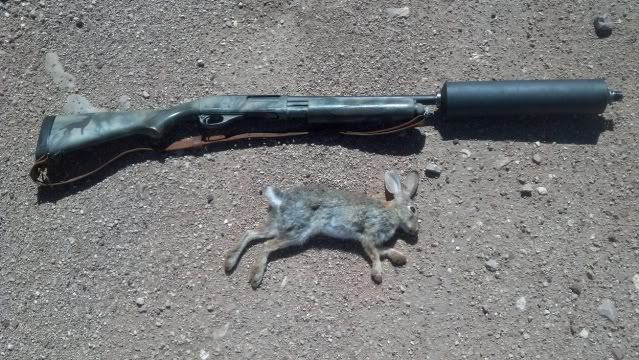
Once we had our fill of prairie dogs (figuratively, not literally) we grabbed some lunch and then got serious about predator hunting again. On the first stand after lunch, myself and 2 other hunters were set up at the edge of a small clearing. I decided to resort back to tried-and-true handcalling and left the FoxPro turned off for this stand. Not 2 minutes into my raspy cottontail distress using a Sceery AP-6, a young coyote came busting out of the treeline and headed right for me like she was on a string. I raised my shotgun (easier said than done with that big ol' suppressor on it!) and with a near silent shot she was in the dirt. That proved to be all for that stand, so we packed up and headed to the next one. Here's a few pictures of what happened - dotted red lines is where she came in from, and the red circle is where I dropped her with a load of 3" #4 buckshot:
We started calling my shotgun "Flamethrower" due the shape of the suppressor, though we also considered calling it "Bilstein" since it also looks like some kind of vehicle part!
On the next stand I called in another coyote with the same Sceery AP-6, but the hunter who saw him only had a 2 second window to shoot, and then the coyote was gone. After that stand, the weather started blessing us with ample amounts of rain and wind, so we headed off to another location:
After one more stand in the wind and looming rain, we decided to call it an early day and headed home to a warm meal and a hot shower. It was a great day, though, with firsts for everyone involved since suppressed hunting just became legal!
I want to give a big thanks to Tim McBride from East Valley Class III for providing me with the "Flamethrower," which is actually the Mark I shotgun suppressor hand made by Tim himself. Mark II and Mark III, which are lighter and more efficient, are currently in the works, and I look forward to putting them to work in the field. And what's the official name for Tim's shotgun suppressor? The QCK - Quiet Coyote Killer. Right on, Tim!
Below is a short video of me putting some rounds through a few of the suppressed hunting tools we used to demo their very quiet nature. Notice the lack of hearing protection - with all of the shooting we did all day, not one of us had so much as an ear buzz. To me, that is one of the biggest advantages of using a suppressor while hunting, especially considering the muzzle blast from a shotgun.
Happy Hunting!
To celebrate this, I went out yesterday with some fellow shooting and hunting enthusiasts to have a good time and we took along some suppressors and absolutely ZERO 'low-capacity' magazines.
I got the first kill of the day with my suppressed Remington 870 using 3" #4 buckshot on this little cottontail:

We didn't have any luck on our first few predator hunting stands, and then we got extremely sidetracked with lots of lots of prairie dogs. I didn't think shooting prairie dogs could be any more fun than it already is, but add in sound suppressors and normal capacity magazines and it's a serious recipe for awesome! We even had a chance to chase a badger around, but unfortunately he ran into his badger hole before we had the chance to turn him into a rug.
Here's just a few of our hunting tools for the day - there were several other suppressed AR-15s in use, as well:
Once we had our fill of prairie dogs (figuratively, not literally) we grabbed some lunch and then got serious about predator hunting again. On the first stand after lunch, myself and 2 other hunters were set up at the edge of a small clearing. I decided to resort back to tried-and-true handcalling and left the FoxPro turned off for this stand. Not 2 minutes into my raspy cottontail distress using a Sceery AP-6, a young coyote came busting out of the treeline and headed right for me like she was on a string. I raised my shotgun (easier said than done with that big ol' suppressor on it!) and with a near silent shot she was in the dirt. That proved to be all for that stand, so we packed up and headed to the next one. Here's a few pictures of what happened - dotted red lines is where she came in from, and the red circle is where I dropped her with a load of 3" #4 buckshot:
We started calling my shotgun "Flamethrower" due the shape of the suppressor, though we also considered calling it "Bilstein" since it also looks like some kind of vehicle part!
On the next stand I called in another coyote with the same Sceery AP-6, but the hunter who saw him only had a 2 second window to shoot, and then the coyote was gone. After that stand, the weather started blessing us with ample amounts of rain and wind, so we headed off to another location:
After one more stand in the wind and looming rain, we decided to call it an early day and headed home to a warm meal and a hot shower. It was a great day, though, with firsts for everyone involved since suppressed hunting just became legal!
I want to give a big thanks to Tim McBride from East Valley Class III for providing me with the "Flamethrower," which is actually the Mark I shotgun suppressor hand made by Tim himself. Mark II and Mark III, which are lighter and more efficient, are currently in the works, and I look forward to putting them to work in the field. And what's the official name for Tim's shotgun suppressor? The QCK - Quiet Coyote Killer. Right on, Tim!
Below is a short video of me putting some rounds through a few of the suppressed hunting tools we used to demo their very quiet nature. Notice the lack of hearing protection - with all of the shooting we did all day, not one of us had so much as an ear buzz. To me, that is one of the biggest advantages of using a suppressor while hunting, especially considering the muzzle blast from a shotgun.
Happy Hunting!
Wednesday, August 8, 2012
Got a look at my first Arizona Red Fox!
I have heard several hunting stories and have even seen a few pictures of red
foxes from the Four Corners area of Arizona. I have always wanted to get up
there and go hunting, but I don't really have a reason to head to that part of
the state (other than the potential for an AZ red fox) unless I am driving to Colorado. A Red Fox is the only predator in AZ
that I have never dropped in the dirt (besides the Long-Tailed Weasel, of
course). Then this last weekend I was heading back from Colorado through the
Four Corners area when I found this:
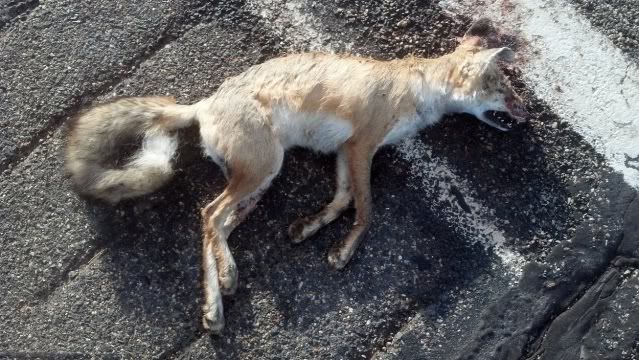
It had been dead for awhile, but at least I got to see my first Arizona Red Fox!

It had been dead for awhile, but at least I got to see my first Arizona Red Fox!
Subscribe to:
Posts (Atom)
